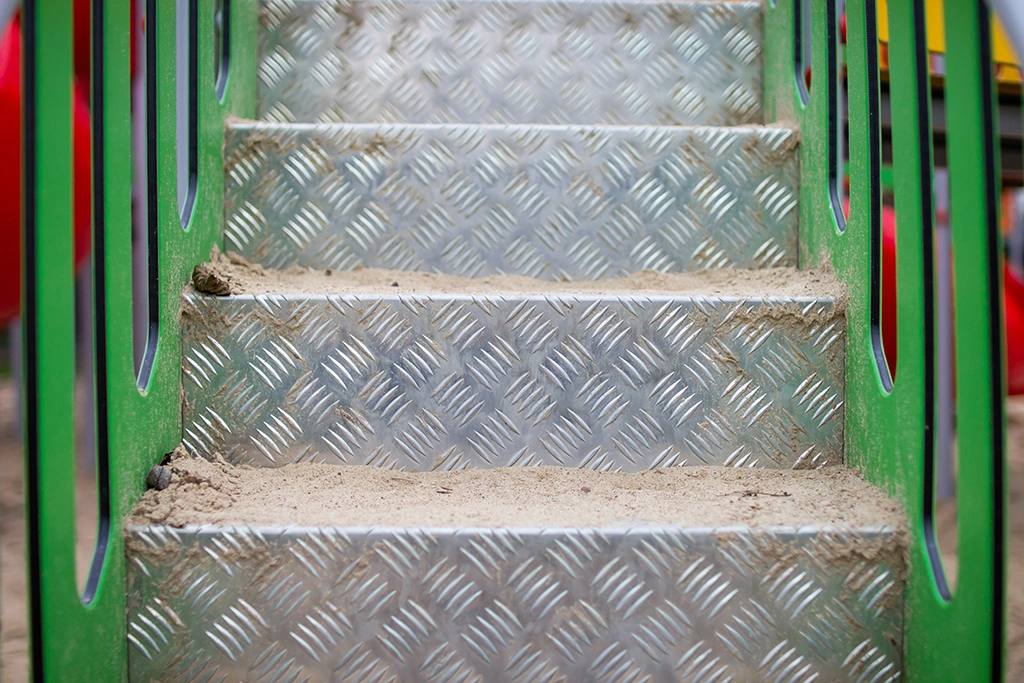Stainless Steel Diamond Plate
Stainless steel diamond plate, also known as tread plate, checker plate, or floor plate, is a type of metal product with a textured surface featuring a raised diamond-shaped pattern. This textured pattern serves multiple purposes, such as enhancing grip and providing slip resistance, making it highly valuable in various industrial and architectural applications. The plate is made from stainless steel, a highly durable and corrosion-resistant material that offers a range of advantages over other types of metals.
Characteristics and Composition:
Stainless steel is an alloy primarily composed of iron, chromium (at least 10.5%), and other elements like nickel, molybdenum, and carbon. The addition of chromium gives stainless steel its signature property of corrosion resistance, as it forms a passive oxide layer on the surface, which protects the steel from rusting. Depending on the application, other elements like nickel or molybdenum can be added to enhance specific characteristics, such as improving its ability to resist corrosion in more aggressive environments or boosting its strength at high temperatures.
The raised diamond pattern on the surface is embossed through a process called hot rolling, in which the stainless steel is heated and passed through rollers with the desired pattern. The diamond plate is typically manufactured in grades such as 304 or 316, each offering specific qualities. Grade 304 is the most common and is known for its excellent resistance to corrosion, while Grade 316, with added molybdenum, offers even better corrosion resistance, particularly in saltwater or chloride-rich environments.
Applications:
Stainless steel diamond plate is widely used across many industries due to its excellent strength, durability, and corrosion-resistant properties. Its raised pattern adds both aesthetic and functional value, which makes it an excellent choice in several applications:
Industrial Flooring: Stainless steel diamond plates are commonly found in factories, warehouses, and other industrial environments where durability and safety are critical. The raised diamond pattern provides excellent traction, reducing the risk of slipping, even in areas exposed to oils, chemicals, or moisture.
Transportation: This material is used in the construction of vehicle flooring, particularly in trucks, trailers, and ramps, where slip resistance is essential. The non-slip surface ensures safe foot traffic and stable transport of goods, especially in commercial vehicles.
Stair Treads and Walkways: In environments where both aesthetics and safety are important, such as in public spaces or architectural structures, stainless steel diamond plates are used for stair treads, platforms, and walkways. The durable nature of stainless steel ensures that these surfaces will last for a long time, even in areas with heavy foot traffic or harsh weather conditions.
Marine Environments: Given its excellent corrosion resistance, especially in saltwater environments, stainless steel diamond plate is frequently used in the marine industry for ship decks, dock ramps, and other coastal infrastructure. Grade 316 stainless steel, in particular, is preferred for its enhanced resistance to corrosion caused by chloride or salt.
Food and Pharmaceutical Industries: Due to its non-reactive nature and hygienic properties, stainless steel diamond plate is used in environments where cleanliness is essential, such as in food processing plants, pharmaceutical labs, and hospitals. It can easily be cleaned and sterilized, making it a good choice for applications requiring a high level of sanitation.
Advantages of Stainless Steel Diamond Plate:
One of the most significant advantages of stainless steel diamond plate is its superior corrosion resistance. Unlike carbon steel, which can rust when exposed to moisture or corrosive substances, stainless steel forms a protective oxide layer that prevents oxidation. This makes it ideal for use in environments exposed to water, chemicals, or extreme weather conditions.
Another key advantage is durability. Stainless steel diamond plates are incredibly strong, able to withstand heavy loads and impacts without bending or warping. This makes them perfect for heavy-duty industrial applications, as well as areas with high foot traffic or constant wear and tear.
The low maintenance requirements of stainless steel are another major benefit. The material does not need to be painted or coated, and it is easy to clean, especially when used in sanitary environments. The high chromium content in the steel prevents tarnishing or staining, ensuring that the diamond plate maintains its appearance over time.
Additionally, stainless steel diamond plate is highly aesthetic. Its bright, polished surface, combined with the textured diamond pattern, provides a sleek, modern appearance that is often used in decorative applications or to create a visually appealing industrial look in architectural designs.
Disadvantages:
Despite its many benefits, stainless steel diamond plate does come with some drawbacks. Cost is one of the most significant factors. Stainless steel is generally more expensive than carbon steel or galvanized steel due to its more complex composition and the additional materials used in its production, such as chromium and nickel.
Another disadvantage is that stainless steel is relatively heavy compared to other materials like aluminum, which can be a drawback in applications where weight is a concern, such as in certain types of transportation or portable structures.
Lastly, while stainless steel is highly resistant to corrosion, it is not entirely immune. In particularly harsh environments, such as those with high chloride concentrations or where the plate is submerged in seawater for extended periods, even stainless steel can corrode over time.
Conclusion:
Stainless steel diamond plate is a versatile, durable, and aesthetically pleasing material with a wide range of applications. Its resistance to corrosion, combined with its strength and low maintenance requirements, make it a popular choice in industries ranging from industrial flooring to architectural design and marine construction. While it may come at a higher cost than other materials, its longevity and performance often make it a worthwhile investment.

